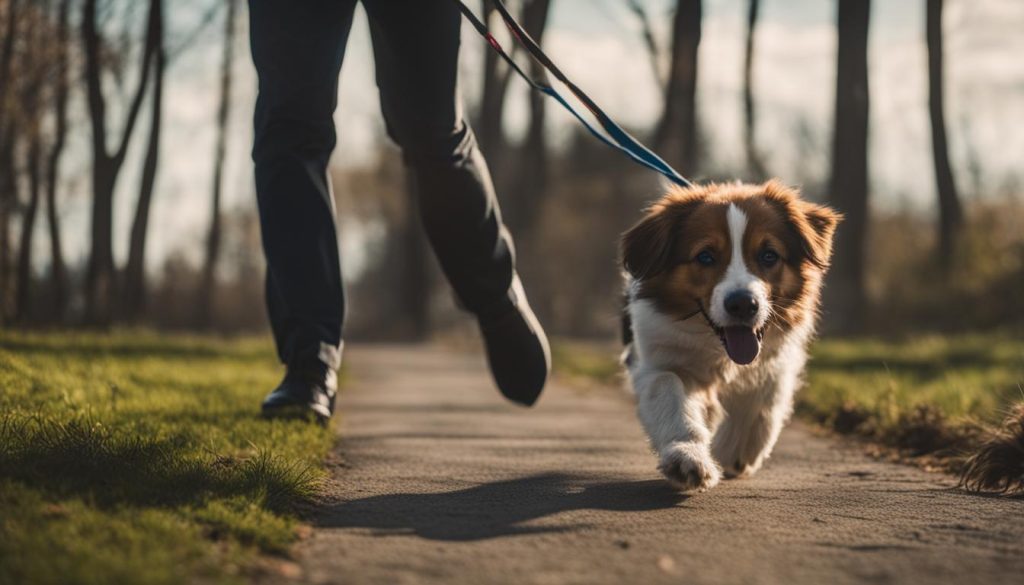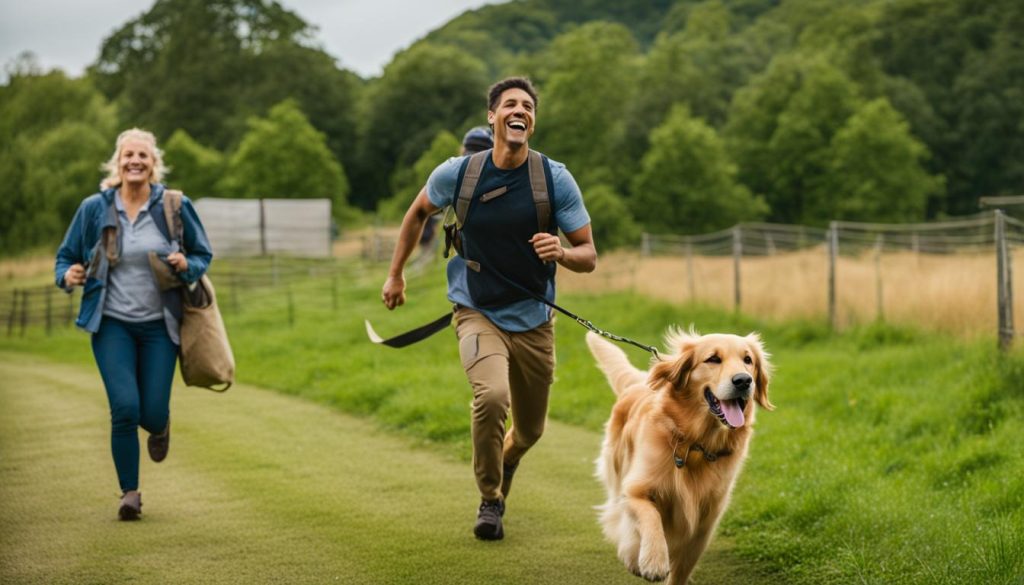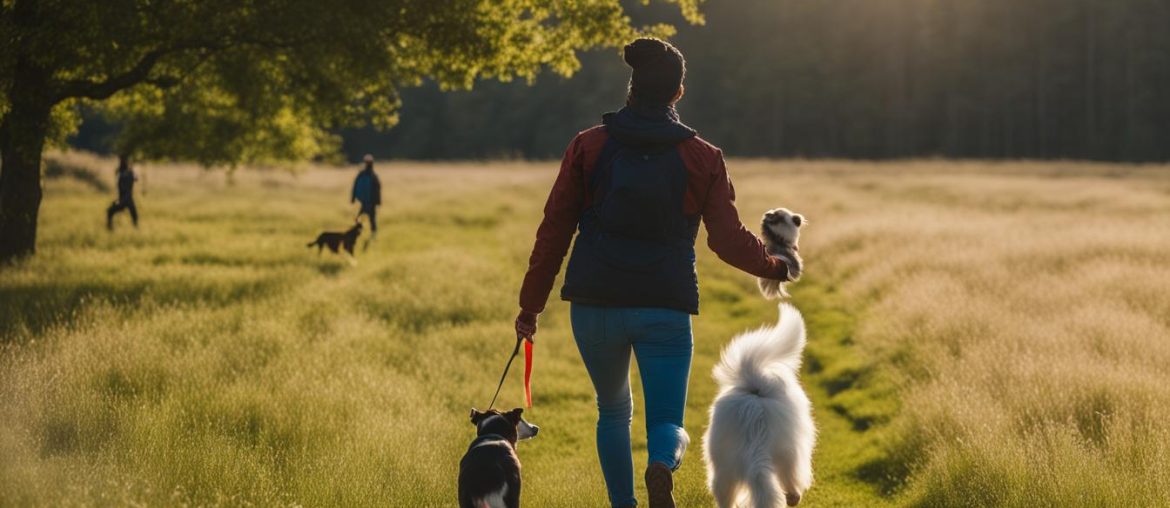Teaching a dog to come when called is an essential behavior for their safety and freedom. By following a few simple steps, you can successfully train your dog to come back to you on command. Use enticing incentives, gradually increase distance, and practice in different environments to ensure a reliable recall.
Key Takeaways:
- Teaching your dog to come when called is crucial for their safety and enjoyment.
- A reliable recall allows them to enjoy off-leash exercise while keeping them out of potential danger.
- Follow these six easy steps to teach your dog to come when called: start with an enticing incentive, run away a few paces and call their name, gently hold their collar and reward them.
- Avoid common training mistakes like rushing the training process or punishing your dog for coming to you.
- Practice recall training daily to reinforce the behavior and improve consistency.
The Importance of Teaching Recall

Teaching your dog to come when called is crucial for their safety and enjoyment. A reliable recall allows them to enjoy off-leash exercise while keeping them out of potential danger. It also gives you peace of mind and allows your dog to explore their environment with greater freedom.
By teaching your dog recall, you are providing them with the skills to navigate various situations safely. Whether it’s crossing a busy street, avoiding hazards, or responding to unexpected stimuli, a reliable recall can be a lifesaver. It enables you to keep your dog under control in any situation, ensuring their well-being.
Additionally, recall training promotes a strong bond between you and your dog. It establishes trust and communication, as your dog learns to respond to your command and return to you promptly. This connection is essential for effective obedience training and overall good behavior. When your dog knows they can rely on you and trusts your guidance, their behavior and responsiveness improve.
Table: Benefits of Recall Training
| Benefit | Description |
|---|---|
| Enhanced Safety | Keeps your dog out of potential danger and allows them to navigate various situations safely. |
| Freedom and Exploration | Enables off-leash exercise and gives your dog the freedom to explore their environment. |
| Bond and Trust | Strengthens the bond between you and your dog, establishing trust and effective communication. |
| Improved Behavior | Promotes overall good behavior and enhances responsiveness to your commands. |
“A reliable recall is not only about keeping your dog safe but also about creating a strong bond and improving their behavior.”
– Professional Dog Trainer
Steps to Teach Your Dog to Come

Teaching your dog to come when called is an important part of their training. Follow these six easy steps to ensure an effective recall:
- Start with an enticing incentive: Begin by using a tasty treat or a fun toy to motivate your dog.
- Run away and call your dog: Take a few steps away from your dog and call their name in an exciting tone. This will encourage them to come towards you.
- Gently hold their collar: As your dog approaches you, gently hold their collar to reinforce the behavior.
- Reward and praise: Once your dog reaches you, reward them with the incentive and praise them for coming.
- Increase the distance: Gradually increase the distance between you and your dog as they become more comfortable with the recall command.
- Practice in different locations: To reinforce the behavior, practice the recall command in various environments such as your backyard, a park, or even inside your home.
Consistency and positive reinforcement are key when teaching your dog to come when called. With patience and practice, your dog will learn to respond reliably to your recall command.
It is important to note that every dog learns at their own pace, so be patient and adjust your training methods accordingly. By following these steps and investing time and effort into recall training, you can establish a strong bond with your dog and ensure their safety and obedience in any situation.
Tips for Effective Recall Training
When it comes to recall training, there are some key tips and strategies that can help ensure success. Here are a few effective techniques to consider:
- Use positive reinforcement: Reward your dog with treats, praise, and play whenever they come to you when called. This positive reinforcement helps to reinforce the behavior and make the command more enticing for your dog.
- Be consistent: Use the same recall command every time, such as “Come” or “Here.” Consistency is key in training and will help your dog associate the command with the desired behavior.
- Keep training sessions short and frequent: Dogs have short attention spans, so it’s best to keep training sessions brief and frequent. Aim for a few minutes of recall training multiple times a day.
- Practice in different environments: Dogs need to learn to come to you in a variety of situations and environments. Start training in a quiet, low-distraction area, then gradually increase the level of distraction and move to different locations, such as parks or busy streets.
By implementing these tips, you can enhance the effectiveness of your recall training and increase the likelihood of your dog coming to you when called.
Making Recall Training a Game

Recall training can be made more enjoyable for both you and your dog by incorporating fun and engaging games. These games not only make the training process more exciting but also strengthen the bond between you and your furry friend. Here are some recall training games that you can try:
Game 1: Catch Me
In this game, you can turn recall training into a playful chase. Start by turning around and running a few steps away from your dog. Then, call your dog to come using an enthusiastic tone. As they come towards you, reward them with praise, treats, or a favorite toy. Repeat this game several times, gradually increasing the distance between you and your dog.
Game 2: Find Me
The “Find Me” game is a great way to test your dog’s recall skills and their ability to locate you. Start by hiding in another room or behind a piece of furniture. Call your dog’s name and encourage them to find you. When they successfully locate you, reward them with treats and praise. This game not only reinforces their recall but also stimulates their natural instinct to search and explore.
Game 3: Hot Potato
The “Hot Potato” game involves multiple people calling your dog between them. This game helps improve their responsiveness and reinforces their recall in different scenarios. To play, have one person call your dog and reward them when they come. Then, have another person call your dog from a different location and repeat the process. This game adds an element of unpredictability and challenges your dog to distinguish between various voices and recall commands.
Remember to keep the games positive and rewarding for your dog. Use treats, praise, and play to reinforce their good behavior. These recall training games make the training sessions enjoyable and increase the likelihood of your dog responding promptly to your recall command.
Avoiding Common Training Mistakes

When it comes to recall training, there are common mistakes that dog owners often make. By being aware of these pitfalls, you can avoid them and ensure a more successful training experience for you and your furry friend.
One of the biggest mistakes is poisoning the recall cue. This happens when you inadvertently associate the recall command with something negative. For example, if you call your dog to come and then scold or punish them, they may start associating the recall command with punishment and become reluctant to come next time. To avoid this, always use positive reinforcement and rewards when your dog comes to you.
Another common mistake is repeating yourself. If you find yourself constantly repeating the recall command without your dog responding, it may indicate that there are distractions in the environment or that your dog doesn’t fully understand the command. Instead of repeating the command, work on training in a less distracting environment and make sure your dog understands the command before adding more distractions.
“One of the biggest mistakes is poisoning the recall cue. This happens when you inadvertently associate the recall command with something negative.”
Lastly, avoid training failures by starting in a low-distraction environment and gradually increasing the difficulty. Rushing the training process can lead to confusion and a lack of reliability in your dog’s recall. Take your time and be patient with the training process to ensure long-term success.
| Common Training Mistakes | How to Avoid |
|---|---|
| Poisoning the recall cue | Use positive reinforcement and rewards, avoid punishment |
| Repeating the recall command | Train in a less distracting environment, ensure understanding |
| Training failures | Start in a low-distraction environment, gradually increase difficulty |
By avoiding these common training mistakes, you can set your dog up for success in recall training. Remember to always use positive reinforcement, take your time, and be patient with the process. With consistency and dedication, you and your dog can achieve a reliable recall command.
Off-Leash Safety Tips

When allowing your dog to roam off-leash, it is crucial to prioritize their safety. Here are some important tips to ensure a secure off-leash experience:
- Create a strong foundation: Before letting your dog off-leash in an open space, establish a reliable recall command in a controlled environment. Practice recall training in a fenced backyard or a quiet park, gradually increasing distance and distractions.
- Carry a leash: Even with a well-trained dog, it’s essential to carry a leash with you at all times. Unforeseen circumstances may arise, such as encountering aggressive dogs or navigating through busy traffic areas. Having a leash handy ensures you can quickly regain control when needed.
- Identification is key: Make sure your dog is microchipped and wears up-to-date identification tags. This ensures that if your dog gets lost or accidentally wanders off, they can be easily identified and reunited with you.
- Respect local regulations: Familiarize yourself with local leash laws and regulations. Different areas may have specific rules about where and when dogs can be off-leash. By adhering to these rules, you not only ensure your dog’s safety but also demonstrate responsible pet ownership.
Remember, safety should always be your top priority when allowing your dog off-leash. By following these tips and investing time in training, you can enjoy the benefits of off-leash freedom while keeping your furry friend safe.
Teaching a Senior Dog to Come

Training a senior dog to come when called may require extra patience and understanding, but it is certainly achievable. Just like with a young pup, the key is to use positive reinforcement and high-value rewards to motivate your older dog.
Start by choosing a quiet and familiar environment to begin the training process. Use a tasty treat or a favorite toy as an enticing incentive. Run a short distance away from your dog and call their name in an upbeat and enthusiastic tone. When they come to you, reward them with praise and a treat.
It’s important to keep training sessions short and frequent, as older dogs may tire more easily. Be consistent with your cues and commands, using the same words or signals each time. Gradually increase the distance and add distractions as your dog becomes more comfortable and confident with the recall command.
Remember to be patient and understanding if your senior dog takes longer to learn or has physical limitations. Adjust the training to their individual needs and always prioritize their comfort and well-being. With dedication and consistency, you can teach your older dog to come when called, providing them with safety and freedom.
Table: Comparing Recall Training for Senior Dogs and Puppies
| Training Aspect | Senior Dogs | Puppies |
|---|---|---|
| Physical Limitations | May require modifications due to age-related stiffness or arthritis | Full range of physical abilities without limitations |
| Past Training Experience | May have previous training or behavioral habits that need to be addressed | Blank slate with no prior training |
| Patience and Persistence | May take longer to learn due to potential cognitive decline | Quick to pick up new commands and behaviors |
| Exercise Needs | Importance of exercise for physical and mental well-being, but consider limitations | High energy levels and need for regular exercise |
By understanding and adapting to the specific needs of your senior dog, you can successfully teach them to come when called. The key is to provide them with positive reinforcement, patience, and a training plan tailored to their capabilities. Remember, it’s never too late to teach an old dog new tricks!
Practice and Consistency
Practice and consistency are key when it comes to recall training. By dedicating regular time and effort to reinforce the behavior, you can ensure that your dog responds reliably when called. Incorporate these essential principles into your training routine to achieve the best results.
Repetition is Key
Consistent practice is crucial for your dog to internalize the recall command. Take advantage of opportunities throughout the day to call your dog to come, reinforcing the behavior in various situations and environments. Whether you’re at home, in the park, or on a walk, seize the chance to practice recall training consistently. The more your dog hears and responds to the command, the better they will become at it.
Reinforce with Rewards
Positive reinforcement is an effective way to motivate and encourage your dog during recall training. Use treats, toys, or verbal praise as rewards when they come to you promptly. By associating the recall command with positive experiences, your dog will be more motivated to respond when called. Remember to vary the rewards to keep the training exciting and engaging for your furry friend.
Gradually Increase Difficulty
As your dog becomes more proficient in coming when called, gradually introduce greater challenges to reinforce their recall skills. Start by practicing in low-distraction environments and then gradually expose them to more distractions, such as other dogs or people nearby. This step-by-step approach helps build your dog’s confidence and reliability, ensuring a consistent response regardless of the circumstances.
| Practice and Consistency Tips |
|---|
| Set aside dedicated time each day for recall training sessions. |
| Vary the training locations to generalize the recall behavior. |
| Gradually increase the distance between you and your dog during training. |
| Ensure your dog is focused and paying attention before calling them to come. |
| Keep training sessions short and engaging to maintain your dog’s interest. |
| Be patient and consistent throughout the training process. |
| Continue to reinforce the recall command even after your dog has mastered it. |
With regular practice and consistent reinforcement, your dog will develop a strong recall response, providing you with peace of mind and the freedom to enjoy off-leash activities together. Remember, practice makes perfect, so keep up the training and soon you’ll have a reliable and attentive furry companion.
Wrapping Up
Teaching your dog to come when called is an essential skill that can provide both safety and freedom. With effective recall training, you can ensure that your dog responds reliably to your command, no matter the situation. By following the steps and tips outlined in this guide, you can successfully train your dog to come back to you on command.
Remember, consistency is key when it comes to recall training. Practice daily and gradually increase the difficulty and distractions in your training sessions. Always use positive reinforcement and rewarding incentives to motivate your dog. By making training a positive and enjoyable experience, you can strengthen the bond between you and your furry companion while achieving a reliable recall.
Never underestimate the importance of recall training. It not only keeps your dog safe but also allows them to experience the joy of off-leash freedom. Whether you’re in a park or enjoying a hike, having a dog that reliably comes when called gives you peace of mind and enhances your dog’s quality of life. So, invest time and effort in training your dog to come when called – it’s a decision that will benefit both of you for years to come.
FAQ
How do I teach my dog to come when called?
Follow these steps: use enticing incentives, gradually increase distance, and practice in different environments.
Why is teaching recall important?
Teaching recall ensures your dog’s safety and allows them to enjoy off-leash exercise.
What are the steps to teach my dog to come when called?
Start with an enticing incentive, run away a few paces, call your dog’s name, and reward them when they come to you.
Any tips for effective recall training?
Only call your dog when you’re going to praise them, avoid calling just to put them back on the leash, and carry treats and toys for rewards.
How can I make recall training more enjoyable?
Try playing the “Catch Me” game or the “Hot Potato” game with multiple people calling your dog.
What common training mistakes should I avoid?
Don’t rush the training process, avoid repeating yourself, and never punish your dog for coming to you.
Any safety tips for off-leash dogs?
Practice recall training in a fenced area or park, carry a leash for emergencies, and respect local leash laws.
Can I teach a senior dog to come when called?
Yes, follow the same training steps but be considerate of their limitations and use positive reinforcement.
How important is practice and consistency in recall training?
Practice daily, gradually increase difficulty, and establish a routine for improved consistency.






